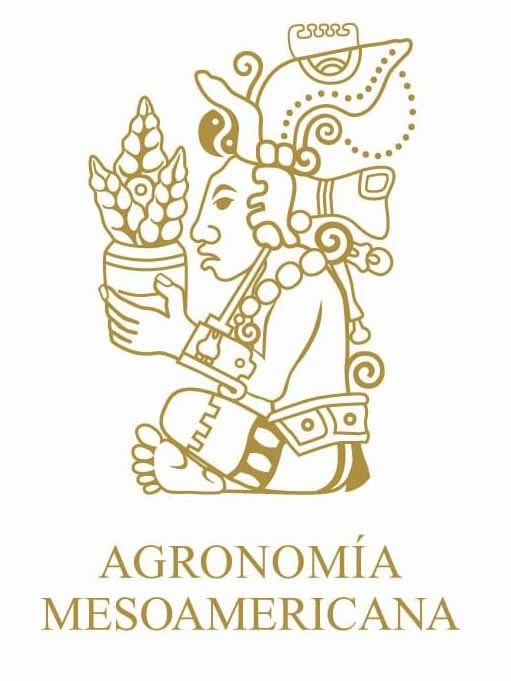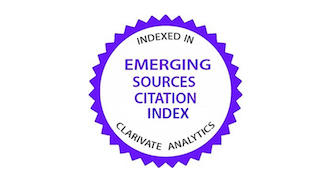Utilización de densidades de plantas y un consorcio microbiano para la producción sostenible de girasol
DOI:
https://doi.org/10.15517/f9zbrr64Palabras clave:
bioestimulantes, densidad de siembra, Helianthus annuus, microorganismos benéficos, rendimientoResumen
Introducción. El uso de los consorcios microbianos (CM) combinado con densidades de plantas (DP) adecuadas puede ser una alternativa viable y amigable para aumentar la producción sustentable de girasol (Helianthus annuus L.). Objetivo. Determinar los efectos individuales y combinados de los consorcios microbianos y las densidades de plantas sobre el crecimiento y rendimiento del girasol en condiciones de déficit hídrico. Materiales y métodos. En condiciones de campo se realizó un experimento distribuido en parcelas divididas, en un diseño de bloques al azar con tres réplicas. Las parcelas principales consistieron en dos DP (20 000 y 40 000 plantas/ha), y las parcelas secundarias en tres concentraciones del CM (0, 100 y 200 mL m-2). Resultados. Los resultados mostraron que, de forma individual, la DP y el CM influyeron directamente en el crecimiento y el rendimiento del girasol. La DP de 40 000 plantas/ha favoreció la altura de la planta, el índice de área foliar, el porcentaje de semillas llenas, la masa de semillas por capítulo y el rendimiento. La DP de 20 000 plantas/ha aumentó el área foliar, el contenido de clorofila, el diámetro del capítulo y la semilla total y llena por capítulo. Además, las concentraciones de 100 mL m-2 de CM estimularon en mayor medida el crecimiento y el rendimiento del girasol en ambas densidades en comparación con los tratamientos sin CM y con 200 mL m-2 de CM. Conclusiones. Los hallazgos de este estudio indican que la combinación entre la densidad de 40 000 plantas/ha y la inoculación con 100 mL m-2 del CM, podría considerarse una estrategia local, viable, importante y amigable para incrementar la producción sustentable de girasol en condiciones de déficit hídrico.
Referencias
Aher, S. B., Lakaria, B. L., Kaleshananda, S., & Singh, A. B. (2022). Concentration and Uptake of Micronutrients (Fe, Zn, Cu and Mn) in Soybean and Wheat under Organic, Biodynamic and Inorganic Nutrient Management in Semi-arid Tropical Conditions of Central India. Communications in Soil Science and Plant Analysis, 53, 2229-2244. https://doi.org/10.1080/00103624.2022.2071434
Andrade, J. F., Ermacora, M., De Grazia, J., Rodríguez, H., Mc Grech, E., & Satorre, E. H. (2023). Soybean seed yield and protein response to crop rotation and fertilization strategies in previous seasons. European Journal of Agronomy, 149, Article 126915. https://doi.org/10.1016/j.eja.2023.126915
Andriienko, O., Vasylkovska, K., Andriienko, A., Vasylkovskyi, O., Mostipan, M., & Salo, L. (2020). Response of sunflower hybrids to crop density in the steppe of Ukraine. Helia, 43, 99-111. https://doi.org/10.1515/helia-2020-0011
Bartucca, M. L., Cerri, M., Del Buono, D., & Forni, C. (2022). Use of Biostimulants as a New Approach for the Improvement of Phytoremediation Performance—A Review. Plants, 11(15), Article 1946. https://doi.org/10.3390/plants11151946
Behera, B., Das, T. K., Raj, R., Ghosh, S., Raza, Md. B., & Sen, S. (2021). Microbial Consortia for Sustaining Productivity of Non-legume Crops: Prospects and Challenges. Agricultural Research, 10, 1-14. https://doi.org/10.1007/s40003-020-00482-3
Calero Hurtado, A., Olivera Viciedo, D., Pérez Díaz, Y., González-Pardo Hurtado, Y., Yánez Simón, L. A., & Peña Calzada, K. (2020). Management planting densities and application of efficient microorganisms that increase rice productivity. Idesia (Arica), 38, 109-117. https://doi.org/10.4067/S0718-34292020000200109
Calero Hurtado, A., Peña Calzada, K., Fasoli, J. V. B., Jiménez, J., & Sánchez López, L. (2025). Synergic effects of the microbial consortium and amino acid-based growth promoter in sunflower productivity under water-deficit conditions. Water, 17, Article 1365. https://doi.org/10.3390/w17091365
Calero-Hurtado, A., Pérez-Díaz, Y., Hernández-González, L., García-Guardarrama, Y., Pacheco-Méndez, S. M., Rodríguez-Pérez, Y., & Castro-Lizazo, I. (2023). Coaplicación entre el consorcio Microorganismos eficientes y Biobras-16® aumentan el crecimiento y la productividad del frijol común. Revista de la Facultad de Ciencias, 12, 64-79. https://doi.org/10.15446/rev.fac.cienc.v12n2.107055
Carabeo, A., Jiménez, J., Gil, Z., Henderson, D., Adams, P., & Calero-Hurtado, A. (2022). Taxonomic identification and diversity of effective soil microorganisms: Towards a better understanding of this microbiome. Agronomía Colombiana, 40, 278-292. https://doi.org/10.15446/agron.colomb.v40n2.101378
Carciochi, W. D., Schwalbert, R., Andrade, F. H., Corassa, G. M., Carter, P., Gaspar, A. P., Schmidt, J., & Ciampitti, I. A. (2019). Soybean seed yield response to plant density by yield environment in North America. Agronomy Journal, 111, 1923-1932. https://doi.org/10.2134/agronj2018.10.0635
Castillo, P., Escalante, M., Gallardo, M., Alemano, S., & Abdala, G. (2013). Effects of bacterial single inoculation and co-inoculation on growth and phytohormone production of sunflower seedlings under water stress. Acta Physiologiae Plantarum, 35, 2299-2309. https://doi.org/10.1007/s11738-013-1267-0
Criollo, H., & García, J. (2011). Efecto de la densidad de siembra sobre el crecimiento de plantas de rábano (Raphanus sativus L.) bajo invernadero. Revista Colombiana de Ciencias Hortícolas, 3, 210-222. https://doi.org/10.17584/rcch.2009v3i2.1214
Dai, Y., Fan, J., Liao, Z., Zhang, C., Yu, J., Feng, H., Zhang, F., & Li, Z. (2022). Supplemental irrigation and modified plant density improved photosynthesis, grain yield and water productivity of winter wheat under ridge-furrow mulching. Agricultural Water Management, 274, Article 107985. https://doi.org/10.1016/j.agwat.2022.107985
de la Vega, A. J., & Hall, A. J. (2002). Effects of planting date, genotype, and their interactions on sunflower yield. Crop Science, 42, 1191-1201. https://doi.org/10.2135/cropsci2002.1191
Devi, R., Kaur, T., Kour, D., & Yadav, A. N. (2022). Microbial consortium of mineral solubilizing and nitrogen fixing bacteria for plant growth promotion of amaranth (Amaranthus hypochondrius L.). Biocatalysis and Agricultural Biotechnology, 43, Article 102404. https://doi.org/10.1016/j.bcab.2022.102404
Díaz, Y. P., Hurtado, A. C., Calzada, K. P., Díaz, J. L. G., & González, V. R. (2024). Plant densities and foliar application of amino acids increasing sesame yield. Temas Agrarios, 29, 100–112. https://doi.org/10.21897/w2sd1542
Etesami, H. (2020). Enhanced Phosphorus Fertilizer Use Efficiency with Microorganisms. En R. S. Meena (Ed.), Nutrient Dynamics for Sustainable Crop Production (pp. 215-245). Springer. https://doi.org/10.1007/978-981-13-8660-2_8
Food and Agriculture Organization of the United Nations. (n. d.). FAOSTAT Statistical Database. Recuperado marzo 23, 2025 de https://www.fao.org/faostat/en/#data
Friedman, S. P. (2024). Relationships between combined and individual field crops’ biomass and planting density. Field Crops Research, 305, Article 109188. https://doi.org/10.1016/j.fcr.2023.109188
Gamboa-Angulo, J., Ruíz-Sánchez, E., Alvarado-López, C., Gutiérrez-Miceli, F., Ruíz-Valdiviezo, V. M., Medina-Dzul, K., Gamboa-Angulo, J., Ruíz-Sánchez, E., Alvarado-López, C., Gutiérrez-Miceli, F., Ruíz-Valdiviezo, V. M., & Medina-Dzul, K. (2020). Efecto de biofertilizantes microbianos en las características agronómicas de la planta y calidad del fruto del chile xcat´ik (Capsicum annuum L.). Terra Latinoamericana, 38, 817-826. https://doi.org/10.28940/terra.v38i4.716
Ghadirnezhad-Shiade, S. R., Fathi, A., Taghavi-Ghasemkheili, F., Amiri, E., & Pessarakli, M. (2023). Plants’ responses under drought stress conditions: Effects of strategic management approaches—a review. Journal of Plant Nutrition, 46, 2198-2230. https://doi.org/10.1080/01904167.2022.2105720
Ghaffari, M., Gholizadeh, A., Rauf, S., & Shariati, F. (2023). Drought-stress induced changes of fatty acid composition affecting sunflower grain yield and oil quality. Food Science & Nutrition, 11, 7718-7731. https://doi.org/10.1002/fsn3.3690
Gómez Ariza, M., Ordóñez Fernández, R., Sánchez Ruiz, F., & Gómez Ariza, M. R. (2022). Girasol en siembra directa: Estrategias de fertilización com microcomplejos y bioestimulantes. Agricultura de Conservación, 50, 8-14. https://agriculturadeconservacion.org/wp-content/uploads/2023/12/revista50web_baja.pdf
González, Y. A., Díaz, Y. P., Hurtado, A. C., & Calzada, K. P. (2025). Plant densities and fertilizers improving sustainable peanut production. Revista de la Facultad de Ciencias, 14, 23-38. https://doi.org/10.15446/rev.fac.cienc.v14n1.113747
Granda-Mora, K., Correa-Ullauri, C., Collahuazo-Reinoso, Y., & Robles-Carrión, Á. (2024). Inoculantes microbianos comerciales con PGPR sobre variables productivas y económicas de fríjol común (Phaseolus vulgaris L.). Agronomía Mesoamericana, 35, 55654-55654. https://doi.org/10.15517/am.2024.55654
Gürsoy, M. (2022). Role of biostimulant priming applications on germination, growth and chlorophyll content of sunflower (Helianthus annuus L.) cultivars under salinity stress. Selcuk Journal of Agriculture and Food Sciences, 36, 75-81. https://dergipark.org.tr/en/pub/selcukjafsci/issue/76375/1275165
Hernández-Jiménez, A., Pérez-Jiménez, J. M., Bosch-Infante, D., Speck, N. C., Hernández-Jiménez, A., Pérez-Jiménez, J. M., Bosch-Infante, D., & Speck, N. C. (2019). La clasificación de suelos de Cuba: Énfasis en la versión de 2015. Cultivos Tropicales, 40, Artículo a15–e15. https://ediciones.inca.edu.cu/index.php/ediciones/article/view/1504/html
Hurtado, A. C., Díaz, Y. P., Calzada, K. P., Viciedo, D. O., Hernández, J. J., & Pérez, A. C. (2023). Coinoculación de biofertilizantes microbianos en pepino y habichuela y su efecto en el crecimiento y rendimiento. Temas Agrarios, 28, 220-232. https://doi.org/10.21897/bz3pzk58
Ibrahim, B. A., Eldey, E. M., Ishag, A. A., & Naim, A. M. E. (2023). Response of sunflower (Helianthus Annuus L) to plant spacing. Innovation in Science and Technology, 2(2), 32-37. https://www.paradigmpress.org/ist/article/view/541
International Union of Soil Sciences. (2022). World reference base for soil resources. International soil classification system for naming soils and creating legends for soil maps (4th ed.). International Union of Soil Sciences. https://www.isric.org/sites/default/files/WRB_fourth_edition_2022-12-18.pdf
Kapadia, C., Sayyed, R. Z., El Enshasy, H. A., Vaidya, H., Sharma, D., Patel, N., Malek, R. A., Syed, A., Elgorban, A. M., Ahmad, K., & Zuan, A. T. K. (2021). Halotolerant microbial consortia for sustainable mitigation of salinity stress, growth promotion, and mineral uptake in tomato plants and soil nutrient enrichment. Sustainability, 13, Article 8369. https://doi.org/10.3390/su13158369
Kemp, C. (1960). Methods of estimating the leaf area of grasses from linear measurements. Annals of Botany, 24, 491-499. https://doi.org/10.1093/oxfordjournals.aob.a083723
Khademian, R., Asghari, B., Sedaghati, B., & Yaghoubian, Y. (2019). Plant beneficial rhizospheric microorganisms (PBRMs) mitigate deleterious effects of salinity in sesame (Sesamum indicum L.): Physio-biochemical properties, fatty acids composition and secondary metabolites content. Industrial Crops and Products, 136, 129-139. https://doi.org/10.1016/j.indcrop.2019.05.002
Li, L., Li, Q., Liu, Y., Xue, H., Zhang, X., Wang, B., Pan, X., Zhang, Z., & Zhang, B. (2024). Diversity, Variance, and Stability of Root Phenes of Peanut (Arachis hypogaea L.). Physiologia Plantarum, 176, Article e14207. https://doi.org/10.1111/ppl.14207
Mathur, P., & Roy, S. (2021). Insights into the plant responses to drought and decoding the potential of root associated microbiome for inducing drought tolerance. Physiologia Plantarum, 172, 1016-1029. https://doi.org/10.1111/ppl.13338
Minh, T. X., Thanh, N. C., Thin, T. H., Tieng, N. T., & Giang, N. T. H. (2021). Effects of Plant Density and Row Spacing on Yield and Yield Components of Peanut (Arachis hypogaea L.) on the Coastal Sandy Land Area in Nghe An Province, Vietnam. Indian Journal of Agricultural Research, 55, 468-472. https://arccjournals.com/journal/indian-journal-of-agricultural-research/A-614
Ministerio de Agricultura. (2020). Cultivos y técnicas para su producción (1a ed.). Ministerio de Agricultura.
Mladenović, E., Cvejić, S., Jocić, S., Ćuk, N., Čukanović, J., Jocković, M., & Marjanović Jeromela, A. (2020). Effect of plant density on stem and flower quality of single-stem ornamental sunflower genotypes. Horticultural Science, 47, 45-52. https://doi.org/10.17221/10/2019-HORTSCI
Outhwaite, C. L., McCann, P., & Newbold, T. (2022). Agriculture and climate change are reshaping insect biodiversity worldwide. Nature, 605, 97-102. https://doi.org/10.1038/s41586-022-04644-x
Raj, D., Kandhro, M. N., Buriro, M., Jamro, G. M., & Channa, S. A. (2024). Effect of agronomic amendments on growth and yield of sunflower. Pakistan Journal of Biotechnology, 21, 120-134. https://doi.org/10.34016/pjbt.2024.21.01.844
Rezaizad, A., Arman, S., Sadatasylan, K., & Mansourifar, S. (2022). Effect of plant density and drought stress on important agronomic characteristics of confectionery sunflower. Environmental Stresses in Crop Sciences, 15, 991-1003. https://doi.org/10.22077/escs.2021.4177.1985
Ríos-Hilario, J. J., Maldonado-Peralta, M. de los Á., RojasGarcía, A. R., Hernández-Castro, E., Sabino-López, J. E., & Segura-Pacheco, H. R. (2023). Comportamiento productivo del cultivo de soya variedad salcer a diferentes densidades de población y momentos de cosecha. Revista Fitotecnia Mexicana, 46, 3-10. https://doi.org/10.35196/rfm.2023.1.3
Rodríguez, L. L., Osa, J. G. de la, & Rigo, M. D. (2018). Efecto de diferentes densidades de siembra sobre el rendimiento del cultivo del girasol (Helianthus annuus L.), var. Caburé – 15 en suelos arroceros. InfoCiencia, 22, 63-72. http://www.infocienciass.cu/index.php/infociencia/article/view/419
Santoyo, G., Guzmán-Guzmán, P., Parra-Cota, F. I., Santos-Villalobos, S. de los, Orozco-Mosqueda, M. del C., & Glick, B. R. (2021). Plant growth stimulation by microbial consortia. Agronomy, 11, Article 219. https://doi.org/10.3390/agronomy11020219
Seibert, M. L., Da Rosa, G. M., Volpi, G. B., Trombetta, L. J., Turchetto, R., & Mahnke, M. R. (2024). Sunflower genotype performance in different spacing in the northeast for Rio Grande do Sul. Contribuciones a las Ciencias Sociales, 17(1), 103-120. https://doi.org/10.55905/revconv.17n.1-007
Shang, J., & Liu, B. (2021). Application of a microbial consortium improves the growth of Camellia sinensis and influences the indigenous rhizosphere bacterial communities. Journal of Applied Microbiology, 130(6), 2029-2040. https://doi.org/10.1111/jam.14927
Simón, L. A. Y., Hurtado, A. C., & de Carvalho, L. B. (2023). Influencia de diferentes densidades de plantas en la productividad de la soya. InfoCiencia, 27, 32-43. http://www.infocienciass.cu/index.php/infociencia/article/view/1281
Simón, L. A. Y., Hurtado, A. C., Pérez, W. B. V., & Carvalho, L. B. de. (2023). Influencia de altas densidades de plantas en la productividad de la soya. Universidad & Ciencia, 12, 155-166. https://doi.org/10.5281/zenodo.11528387
Singh, A., Kumari, R., Yadav, A. N., Mishra, S., Sachan, A., & Sachan, S. G. (2020). Tiny microbes, big yields: Microorganisms for enhancing food crop production for sustainable development. In A. A. Rastegari, A. N. Yadav, & N. Yadav (Eds.), New and Future Developments in Microbial Biotechnology and Bioengineering (pp. 1-15). Elsevier. https://doi.org/10.1016/B978-0-12-820526-6.00001-4
Soleymani, A. (2017). Light response of sunflower and canola as affected by plant density, plant genotype and N fertilization. Journal of Photochemistry and Photobiology B: Biology, 173, 580-588. https://doi.org/10.1016/j.jphotobiol.2017.06.038
Zapletalová, A., Ernst, D., & Černý, I. (2023). Effect of growing factors on production and fatty acid composition of sunflower schenes. Acta Fytotechnica et Zootechnica, 26, 305-313. http://acta.fapz.uniag.sk/journal/article/view/266
Zheng, B., Zhang, X., Wang, Q., Li, W., Huang, M., Zhou, Q., Cai, J., Wang, X., Cao, W., Dai, T., & Jiang, D. (2021). Increasing plant density improves grain yield, protein quality and nitrogen agronomic efficiency of soft wheat cultivars with reduced nitrogen rate. Field Crops Research, 267, Article 108145. https://doi.org/10.1016/j.fcr.2021.108145
Descargas
Publicado
Licencia
Derechos de autor 2025 Yanery Pérez-Díaz, Alexander Calero-Hurtado, Kolima Peña Calzada, Alay Jiménez Medina (Autor/a)

Esta obra está bajo una licencia internacional Creative Commons Atribución-NoComercial-SinDerivadas 4.0.
1. Política propuesta para revistas de acceso abierto
Los autores/as que publiquen en esta revista aceptan las siguientes condiciones:
- Los autores/as conservan los derechos morales de autor y ceden a la revista el derecho de la primera publicación, con el trabajo registrado con la licencia de atribución, no comercial y sin obra derivada de Creative Commons, que permite a terceros utilizar lo publicado siempre que mencionen la autoría del trabajo y a la primera publicación en esta revista, no se puede hacer uso de la obra con propósitos comerciales y no se puede utilizar las publicaciones para remezclar, transformar o crear otra obra.
- Los autores/as pueden realizar otros acuerdos contractuales independientes y adicionales para la distribución no exclusiva de la versión del artículo publicado en esta revista (p. ej., incluirlo en un repositorio institucional o publicarlo en un libro) siempre que indiquen claramente que el trabajo se publicó por primera vez en esta revista.
- Se permite y recomienda a los autores/as a publicar su trabajo en Internet (por ejemplo en páginas institucionales o personales) antes y durante el proceso de revisión y publicación, ya que puede conducir a intercambios productivos y a una mayor y más rápida difusión del trabajo publicado (vea The Effect of Open Access).






























